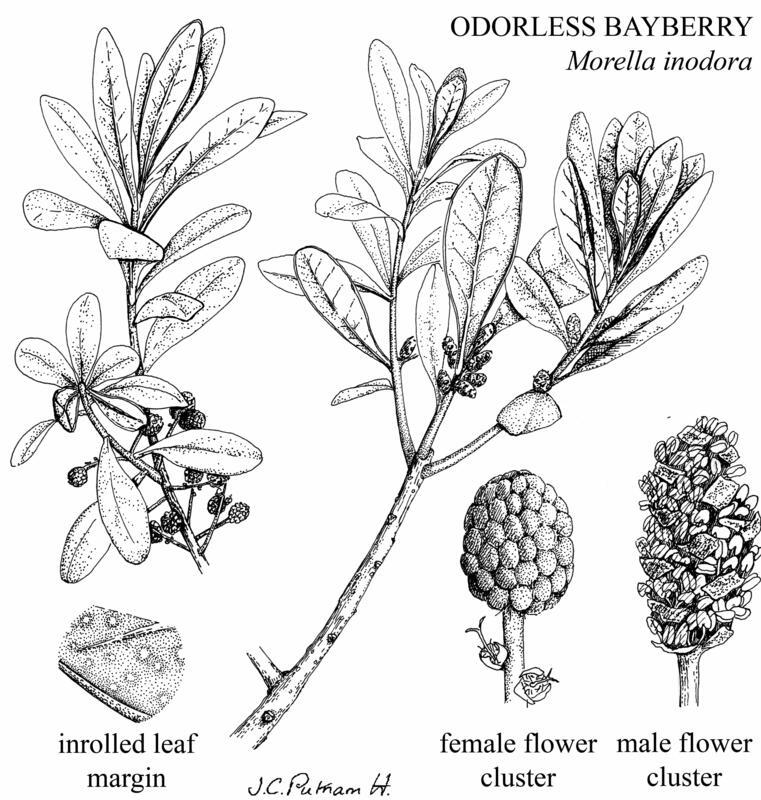







Loading profile. Please wait . . .
Morella inodora (Bartr.) Small
Odorless Bayberry





Federal Protection: No US federal protection
State Protection: Threatened
Global Rank: G4
State Rank: S1?
Element Locations Tracked in Biotics: Yes
SWAP 2015 Species of Greatest Conservation Need (SGCN): Yes
SWAP 2025 Species of Greatest Conservation Need (SGCN): Yes
2025 SGCN Priority Tier: High Conservation Concern
Element Occurrences (EOs) in Georgia: 4
Habitat Summary for element in Georgia: Bayheads, titi swamps; forests with pond pine
Evergreen shrub up to about 23 feet (7 meters) tall, usually much shorter, with smooth, hairless twigs. The leaves are up to 4.6 inches (3.5 - 11.8 cm) long and 1.7 inches (1.4 - 4.4 cm) wide, alternate, dark green, oval with blunt or rounded tips and tapering bases, thick and leathery, odorless when crushed; margins have few or no teeth and are slightly rolled under; both upper and lower surfaces are dotted with clear or white, odorless glands. Plants are dioecious, so female and male flowers are usually produced on separate plants; they are very small, golden-brown, and tightly packed into rounded clusters. Fruit about 0.25 inch (4 - 8 mm) wide, oval, blue-black, warty with white wax between the bumps, on conspicuous stalks.
Other Bayberry species in Georgia’s Coastal Plain (Morella cerifera and M. heterophylla) have amber gland dots on the lower surface of the leaves that exude a spicy smell when crushed; their fruits are round and waxy, and clustered tightly along the stems.
Dahoon (Ilex cassine) has leathery, bristle-tipped leaves and red berries. Wild Olive (Osmanthus americanus) leaves are leathery but opposite with pointed tips.
Sweet-fern (Comptonia peregrina, Special Concern) forms colonies of shrubs to 5 feet tall (1.5 meters) in disturbed areas and open, upland forests in Rabun and White Counties. Its spicy-smelling leaves are up to 6 inches (15 cm) long and ¾ inch (1.8 cm) wide, with scalloped edges cut almost to the midvein. Its male-flowered catkins are cylindrical in shape, the female-flowered catkins are round. For more information, see: http://www.efloras.org/florataxon.aspx?flora_id=1&taxon_id=233500420 For images, see: https://gobotany.nativeplanttrust.org/species/comptonia/peregrina/
Bayheads, Titi swamps, moist to wet pinelands; often with Pond Pine, Titi, Buckwheat Tree, Fetterbush, and Swamp Azalea.
Morella inodora (synonym Myrica inodora) is dioecious – female and male flowers are on separate plants. Bayberry flowers are wind-pollinated. The fruits are eaten and dispersed by birds who benefit from the fat-rich, waxy coating on the berries. The roots of Bayberries and Wax Myrtles have nodules containing nitrogen-fixing bacteria which convert atmospheric nitrogen to a form of nitrogen that plants can use, allowing these plants to grow in the usually nitrogen-poor soils of wetlands.
Flowering occurs in late winter–early spring and fruiting in summer–fall. Plants can usually be identified all year by their leaves.
Coastal Plain of Georgia, Florida, Alabama, Mississippi, and Louisiana.
Fire suppression. Ditching and draining in wetlands. Rooting by feral hogs. Conversion of habitat to pine plantations and residential and commercial development.
Morella inodora is ranked S1? by the Georgia Department of Natural Resources, indicating that it is probably critically imperiled in Georgia but that current data are not sufficient to make a definitive ranking. Only four populations have been documented in Georgia, with one in a state conservation land. None have been confirmed in the last 20 years.
Apply prescribed fire every 2 - 3 years, primarily during the growing season; plants will vigorously re-sprout. Avoid placing firebeaks in wetlands. Avoid ditching, draining, and clearcutting in wetlands. Eradicate feral hogs.
Bornstein, A.J. 1997. Myrica inodora species account. Flora of North America, Vol. 3. Oxford University Press, New York. http://www.efloras.org/florataxon.aspx?flora_id=1&taxon_id=233500793
Chafin, L.G. 2007. Field guide to the rare plants of Georgia. State Botanical Garden of Georgia and University of Georgia Press, Athens.
Foote, L.E. and S.B. Jones, Jr. 1989. Native shrubs and woody vines of the southeast. Timber Press, Portland, Oregon.
GADNR. 2020. Element occurrence records for Morella inodora. Georgia Department of Natural Resources, Wildlife Resources Division, Social Circle, Georgia.
Godfrey, R.K. 1988. Trees, shrubs, and woody vines of northern Florida and adjacent Georgia and Alabama. University of Georgia Press, Athens.
Kirkman, L.K., C.L. Brown, and D.J. Leopold. 2007. Native trees of the southeast. Timber Press, Portland, Oregon.
NatureServe. 2019. Morella inodora comprehensive report. NatureServe Explorer. Arlington, Virginia. http://explorer.natureserve.org/servlet/NatureServe?searchName =Morella+inodora
Nelson, G. 1996. Shrubs and woody vines of Florida. Pineapple Press, Sarasota, Florida.
Radford, A.E., H.E. Ahles, and C.R. Bell. 1968. Manual of the vascular flora of the Carolinas. University of North Carolina Press, Chapel Hill.
Weakley, A.S. 2015. Flora of the southern and mid-Atlantic States. University of North Carolina Herbarium, University of North Carolina, Chapel Hill. http://www.herbarium.unc.edu/flora.htm
Wilbur, R.L. 1994. The Myricaceae of the United States and Canada: genera, subgenera, and series. Sida 16: 93-107. https://www.jstor.org/stable/41967085?seq=1
Linda G. Chafin
L. Chafin, Jun 2008: original account
K. Owers, Feb 2010: added pictures
L. Chafin, Mar 2020: updated original account


